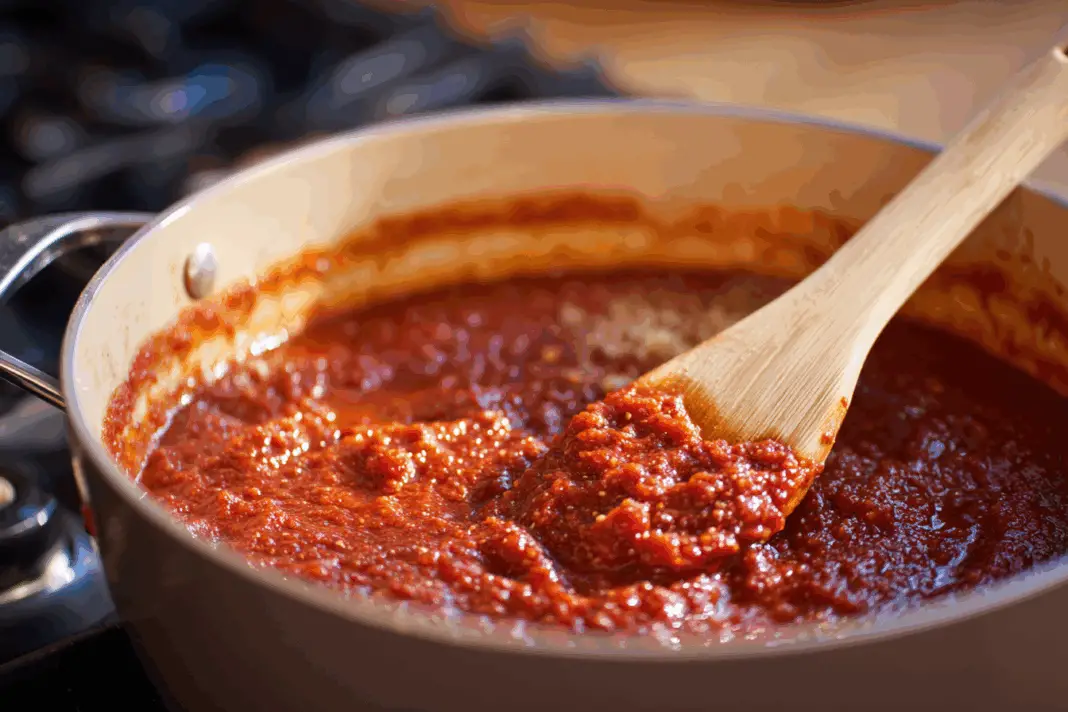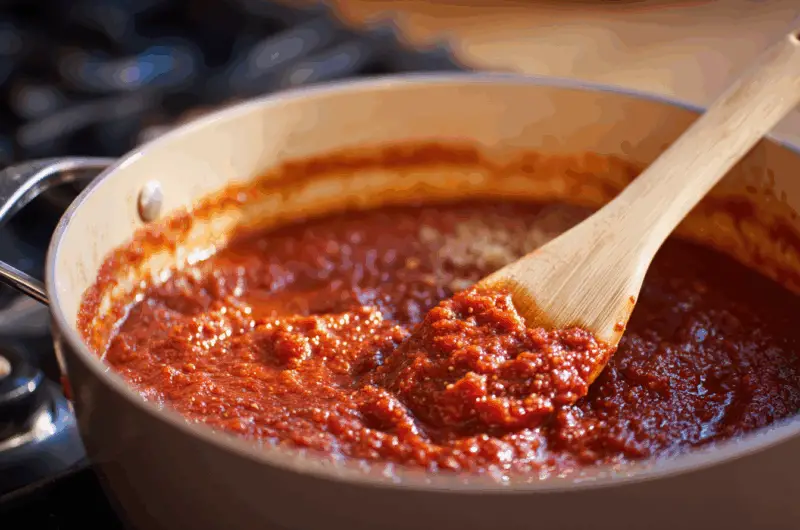Most home cooks think they know everything about making spaghetti sauce, but there’s one ingredient sitting in nearly every kitchen that can transform even the most basic sauce into something restaurant-worthy. This simple addition doesn’t just improve the taste – it completely changes how all the other ingredients work together, creating depth and richness that most people assume only comes from hours of simmering or expensive ingredients.
Instant coffee creates unexpected depth
Adding a single teaspoon of instant coffee to spaghetti sauce might sound crazy, but this trick has been quietly used by professional chefs for years. The coffee doesn’t make the sauce taste like your morning brew – instead, it adds a subtle bitterness that makes all the other ingredients pop. Think of it like adding salt to chocolate chip cookies; the contrast enhances everything else.
The slightly bitter notes from instant coffee work especially well with sweet elements like sugar or carrots in the sauce. Even store-bought sauce that tastes flat and one-dimensional becomes more complex with this addition. Regular brewed coffee works too, but instant dissolves completely without adding extra liquid that might thin out the sauce.
Charred tomato paste builds smoky foundation
Before adding any other ingredients, spread a thin layer of tomato paste on the bottom of the pot with a few drops of olive oil. Let it cook on medium-low heat until it caramelizes and develops char marks. This creates a smoky base that infuses the entire sauce as it cooks, giving it the kind of depth that usually takes hours to develop.
The charred bits will naturally flake off during cooking and integrate into the sauce, while larger pieces can be easily removed. If forgotten at the beginning, the same effect happens by avoiding stirring too much – a thin layer forms on the pot walls and develops that same charred taste that authentic Italian sauces are known for.
Sugar balances harsh acidity perfectly
Canned tomatoes can be surprisingly harsh and acidic, especially when they’re the star of the show in spaghetti sauce. A tablespoon or two of sugar transforms this sharpness into a balanced, rounded taste that doesn’t overwhelm the palate. Brown sugar and raw sugar work particularly well because they add subtle molasses notes that complement the tomatoes naturally.
Other sweeteners like maple syrup, honey, or agave work just as effectively for those who prefer natural alternatives. The key is adding gradually and tasting frequently – it’s much easier to add more sweetness than to fix an overly sweet sauce. Start with a teaspoon, stir well, let it simmer for a few minutes, then taste before adding more.
Grated carrots add natural sweetness
Finely grated carrots serve double duty in spaghetti sauce by naturally reducing acidity while adding body and thickness. Their alkaline properties counteract the sharp tang of canned tomatoes, creating a more mellow overall taste. The key is grating them as finely as possible so they dissolve into the sauce rather than creating chunky bits.
For completely smooth sauce, blend the carrots into a puree before adding them. However, some cooks prefer dropping two small peeled carrot sticks into the sauce while it simmers, then removing them before serving. This method provides the acidity-balancing benefits without adding extra sweetness that some people find overwhelming in their sauce.
Baking soda neutralizes without sweetness
When acidity is the problem but added sweetness isn’t wanted, baking soda provides the perfect solution. Just two small pinches added during simmering will neutralize harsh acids and create a smoother texture throughout. The alkaline nature of baking soda directly counteracts the acidic tomatoes without introducing any competing flavors.
Add the baking soda once the sauce starts bubbling, then stir while it fizzes briefly. Let everything cook together for several minutes before tasting to allow the baking soda to fully integrate. This method works especially well for people who prefer savory sauces without any hint of sweetness from sugar or carrots.
Fresh nutmeg enhances earthiness
A quarter teaspoon of freshly grated nutmeg adds warmth and complexity that most people can’t identify but definitely notice. This spice enhances the natural earthiness of tomatoes while contributing subtle sweetness and nuttiness. Many classic Italian sauces include nutmeg, so this addition actually makes homemade sauce more authentic rather than experimental.
The effect is cumulative rather than immediately obvious – nutmeg makes all the other ingredients taste more like themselves. If too much gets added accidentally, extra garlic can mask the overwhelming nutmeg taste, but it won’t ruin the entire batch. Start with three dashes and adjust from there based on the sauce size.
Butter creates creamy richness
Sautéing onions in butter instead of olive oil creates a richer base that elevates the entire sauce. The fat content helps carry and blend all the other flavors while adding a subtle creaminess that makes the sauce feel more luxurious. When butter gets heated during the sautéing process, it develops deeper, nuttier notes that enhance rather than compete with the tomatoes.
For fresh tomato sauces, cooking the tomatoes directly in the butter and onion mixture creates an even more integrated flavor profile. The vegetables cook down together, creating a velvety texture that’s noticeably different from oil-based sauces. This technique works particularly well for people who find traditional marinara too thin or acidic.
Red wine adds sophisticated depth
Adding a cup to cup and a half of full-bodied red wine transforms basic sauce into something that tastes like it came from an upscale Italian restaurant. The alcohol cooks off completely during simmering, leaving behind rich, peppery notes that enhance the tomatoes’ natural flavors. The wine also adds either sweetness or dry complexity depending on the variety chosen.
Don’t worry about the sauce becoming too liquidy – the alcohol evaporates during cooking, and reducing other liquids slightly compensates for the extra volume. The wine addition works especially well when combined with other umami-rich ingredients like mushrooms or cheese. Choose a wine that’s good enough to drink, since cooking concentrates both good and bad flavors.
Parmesan rinds boost umami naturally
Instead of throwing away Parmesan rinds, toss them into simmering sauce for an instant umami boost. The rinds are packed with concentrated cheese flavor that slowly releases during cooking, creating the kind of savory depth that usually requires expensive ingredients or hours of preparation time. This trick has been used by Italian grandmothers for generations.
Large chunks or whole rinds work equally well – just remove them before serving like bay leaves. It’s nearly impossible to overdo this addition, so don’t hold back when adding the Parmesan rinds. The cheese flavor integrates beautifully with tomatoes and herbs, making the finished sauce taste more complex and restaurant-quality even when using basic ingredients.
These simple additions prove that amazing spaghetti sauce doesn’t require expensive ingredients or complicated techniques. Most of these items are already sitting in the average kitchen, waiting to transform ordinary marinara into something special. Try one or two at a time to see which improvements make the biggest difference for personal taste preferences.
Secret Ingredient Spaghetti Sauce
Cuisine: Italian6
servings15
minutes45
minutes120
kcalTransform ordinary spaghetti sauce with this game-changing recipe that uses surprising ingredients to create restaurant-quality depth and richness.
Ingredients
1 tablespoon olive oil
2 tablespoons tomato paste
1 medium onion, finely chopped
3 garlic cloves, minced
1 large carrot, finely grated
28 oz can crushed tomatoes
1 teaspoon instant coffee
1 tablespoon granulated sugar
1/4 teaspoon fresh nutmeg
1/2 cup red wine
2 Parmesan rinds
Salt and black pepper to taste
1/4 cup fresh basil, chopped
Directions
- Heat olive oil in a large pot over medium-low heat. Spread tomato paste evenly across the bottom of the pot and let it caramelize for 3-4 minutes until it develops dark spots and becomes fragrant. This creates the smoky base that will enhance the entire sauce.
- Add chopped onions and grated carrots to the pot, stirring to combine with the charred tomato paste. Cook for 5-7 minutes until the vegetables soften and the onions become translucent. The carrots will help balance the acidity naturally while adding body to the sauce.
- Stir in minced garlic and cook for another minute until fragrant. Add the crushed tomatoes, red wine, and instant coffee, stirring well to combine all ingredients. The coffee will add depth without making the sauce taste like coffee.
- Season with salt, pepper, sugar, and fresh nutmeg, then add the Parmesan rinds to the pot. Bring the mixture to a gentle boil, then reduce heat to low and let it simmer uncovered. The Parmesan rinds will slowly release their flavor into the sauce.
- Allow the sauce to simmer for 30-35 minutes, stirring occasionally to prevent sticking. The sauce should reduce and thicken during this time, developing rich, complex flavors from all the secret ingredients working together.
- Remove the Parmesan rinds from the sauce and discard them. Taste the sauce and adjust seasoning as needed, adding more salt, pepper, or sugar according to preference. The sauce should be well-balanced with no harsh acidity.
- Stir in fresh chopped basil during the last few minutes of cooking to preserve its bright flavor. The herbs should be added at the end to maintain their freshness and prevent them from becoming bitter from overcooking.
- Serve immediately over cooked pasta or store in the refrigerator for up to 4 days. The sauce can also be frozen for up to 3 months and will actually improve in flavor as the ingredients continue to meld together over time.
Notes
- Regular brewed coffee can substitute for instant coffee – use 2-3 tablespoons of strong coffee instead
- If sauce becomes too thick during simmering, add pasta cooking water or regular water in small amounts
- For vegetarian version, omit Parmesan rinds and add extra nutritional yeast for umami flavor
- Don’t use all acid-reducing ingredients at once – choose 1-2 methods to avoid over-correcting
Frequently asked questions
Q: Will the instant coffee make my sauce taste like coffee?
A: No, when used in the small amount called for (1 teaspoon), the coffee adds depth and enhances other flavors without creating any noticeable coffee taste. It works similarly to how vanilla enhances chocolate without making everything taste like vanilla.
Q: Can I use multiple acid-reducing ingredients together?
A: It’s better to start with just one or two methods at a time. Using sugar, carrots, and baking soda all together might over-correct the acidity and create an unbalanced sauce. Try one method first, taste, then adjust if needed.
Q: How do I know if I need to reduce acidity in my sauce?
A: If your sauce tastes sharp, harsh, or makes you pucker slightly when tasting, it’s too acidic. A well-balanced sauce should taste rich and round without any harsh bite from the tomatoes.
Q: Can I use these techniques with store-bought sauce?
A: Absolutely! Most of these ingredients can be added to jarred sauce to improve its flavor. Start with smaller amounts since you’re working with less volume, and simmer for 10-15 minutes to let the additions integrate properly.


